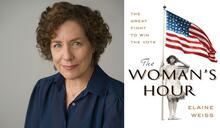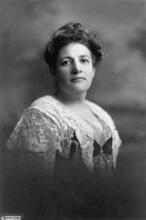Annie Nathan Meyer
Believing that education was the best path for women’s success, Annie Nathan Meyer founded Barnard College, New York’s first liberal arts college for women. After Barnard opened in 1889, Meyer served on the board of trustees, continued her fundraising and publicity work for the new school, and raised scholarship money for Zora Neale Hurston, the first African American student at Barnard, as well as future students of color. In addition to championing African American students, Meyer helped raise money for Jewish students and spoke out against antisemitism. Meyer also pursued her dreams as a writer and dramatized women’s status in well-received plays, novels, and short stories. She completed an autobiography days before her death, entitled It’s Been Fun.
“Had my ambition been less, the gap between idea and fulfillment would perhaps have been slighter.” With these words, Annie Nathan Meyer concluded her autobiography It’s Been Fun (1951), published just days after her death. Her ambition may have exceeded her achievements, but the latter were neither few nor insignificant. She promoted women’s higher education; chronicled women’s work; dramatized women’s status in plays, novels, and short stories; raised funds for Jewish and black students; wrote hundreds of letters to the editor; published art, drama, and music criticism; and championed physical activity and the outdoors. She was also founder of Barnard College, New York City’s first liberal arts college for women.
Early Life & Family
Descended from the distinguished Gershom Mendes Seixas family of precolonial times, Annie Nathan Meyer, born on February 19, 1867, was the fourth child and second daughter of Robert Weeks and Annie Augusta (Florance) Nathan. Having had less than six months of schooling, she was self-educated, boasting that she had read all of Dickens by the time she was seven years old. The Crash of 1873 damaged her parents’ financial status and, in 1875, the family moved from New York to Green Bay, Wisconsin, where one of her mother’s admirers controlled railroad interests that allowed him to employ her father and her eldest brother, Robert. Her mother resented being forced from her extensive social life, amateur theater, and large family, and her father resented being dependent on her friend’s largess. Neither was comfortable living away from New York City. Their marriage deteriorated, with each bringing admirers home. Although her mother sent Maud and Harold, the two middle children, to public school, she kept Annie home to keep her company, denying Annie normal peer experiences.
After three unhappy years, her father returned to New York, while Annie, her mother, Maud, and Harold moved to Chicago to build a new life. This move was even more disastrous than the first. In Chicago, she saw her mother invest poorly, suffer depression, and eventually turn to drugs, which led to her death. In 1878, the children returned to New York to live with their maternal grandfather and then with their father.
Early Writing & Marriage
When Maud married in 1880, Annie took charge of the Nathan household and allowed herself time to read and study. By 1885, she had organized a reading circle modeled after Margaret Fuller’s conversations and enrolled in the newly established Columbia College Collegiate Course for Women. Her abiding interest, however, was writing, and she modeled her own writing after the writers she admired most at that time: Ralph Waldo Emerson, Margaret Fuller, George Eliot, Elizabeth Barrett Browning. Another strong interest, music, led her to join a sight-reading piano group, where she met Alfred Meyer, a pulmonologist thirteen years her senior. He claimed love at first sight and convinced her to marry him, promising her explicitly that he would support her writing and her use of Annie Nathan Meyer as her legal name. They married on February 15, 1887, four months after they met, and literally played piano duets for the next sixty years. An assimilated German Jew, Alfred Meyer rejected synagogue affiliation. Annie Nathan Meyer left Congregation Shearith Israel, the synagogue with which her family had been affiliated for generations, and soon joined the Ethical Culture Society. Her interests in anticlericalism and reconciling Judaism and Christianity are reflected in her well-received novel, Robert Annys, Poor Priest (1901). The Meyers had one daughter, Margaret, born in 1894, who died tragically and mysteriously from an accidental self-inflicted gunshot wound in 1923, just three months after she married Dr. Ira Cohen.
Founding of Barnard College
Because her husband was a Columbia alumnus, Annie Nathan Meyer used the Columbia library, obviating her need to continue with the Columbia correspondence course. However, she wanted to study with the same intellectual rigor that was required of male students. A casual meeting with Columbia chief librarian Melvil Dewey, in 1887, led to planning a strategy to establish an affiliate women’s college at Columbia. What was intended as a seven-year plan was accomplished in two. Meyer began her campaign in January 1888, with a memorable 2,500-word letter to The Nation, arguing that New York had no real claim to culture because, unlike other major cities, it lacked a liberal arts college for women. As part of the strategy, she then visited each name on a list of potential donors. Together with Dewey, Mary Mapes Dodge, and Ella Weed, she prepared a petition to Columbia’s trustees urging the founding of an affiliated self-sustaining liberal arts women’s college. Naming the college for Frederick A.P. Barnard, a strong advocate for coeducational education, precluded Mrs. Barnard from objecting to the compromise of a separate but affiliated women’s college. On October 7, 1889, Barnard College opened with seven full-time and twenty-nine part-time students at 343 Madison Avenue, with three years’ rent guaranteed by the Meyers. Annie Nathan Meyer organized Barnard’s first board of trustees, appointed herself, and remained active until 1950, often taking responsibility for promoting the college in the press, informally mentoring students, but mainly fund-raising. She often solicited friends to raise money for Jewish students’ tuition and expenses.
Although founding Barnard College was her most important contribution to the higher education of women, her relationship with the college was not without significant problems, primarily because she felt slighted by not being acknowledged as its founder. By the 1930s, another source of acrimony developed from her insistence in having Barnard Hall renamed for its donor, Jacob H. Schiff. A long correspondence with Nicholas Murray Butler, Columbia University president, and Virginia Gildersleeve, Barnard College dean, regarding the naming of the building was fruitless. Meyer and the Schiffs attributed Butler’s refusal to antisemitism.
Views on Suffrage
In 1891, Meyer edited Woman’s Work in America, a book that focused on fields in which women had made some progress: education, law, medicine, journalism, and philanthropy (social welfare). In 1892, Meyer published a short, memorable novel, Helen Brent, M.D., about a woman who faces the agonizing choice between career and marriage, and chooses medicine. In subsequent plays and stories, Meyer dramatized the “woman question” and reflected a “separate spheres” ideology, which evolved into a conservative antisuffrage position. Meyer’s best scenes explore the hypocrisy behind the double standard, the dilemmas of working wives and mothers, and the unsupported claim that women’s participation in public life ameliorates society’s problems. To Meyer, motherhood placed a woman into a protected, if not sacred, class. Childless women were free to pursue the professions, but not vote. Meyer saw no inconsistencies in her indisputable achievement in expanding women’s higher education and her antisuffragism. This enigmatic stance may be traced to her intense jealousy of her sister, Maud, who was a progressive activist and well-known suffragist, and her impatience with the suffragists’ claims about the social and political changes the women’s vote would bring. In a widely reprinted article, “Women’s Assumption of Sex Superiority” (1904), she introduced a term to describe these overstated claims—“spreadhenism”—and argued that women could bring about social reforms without suffrage. She supported an educational, not a gender-based, voting criterion. Later, she defended her position by stating that the suffragists should have claimed the vote on the principles of justice and equality, not on unrealistic promises. Nevertheless, she eventually joined the League of Women Voters. Another point of disagreement was the suffragists’ pacifism. Supportive of war preparedness, Meyer chaired the Emergency Committee of the American Home Economics Association and supervised the production of the film Cheating the Garbage Pail (1917), which addressed home-front food shortages.
Work for Minority Rights
Meyer was sincerely interested in minority rights. Because it sanctioned segregation, she resigned from the Daughters of the American Revolution. She worked with Mary White Ovington, Roy Wilkins, E.E. Just, James Weldon Johnson, and others to raise funds for black college students. The National Association for the Advancement of Colored People called her to resolve conflicts between blacks and Jews. After meeting Zora Neale Hurston, she found donors to support Hurston at Barnard, breaking the color barrier. For many years, Meyer and Hurston corresponded about Hurston’s academic and social experiences at Barnard, her graduate research in anthropology at Columbia, and their writing. Hurston dedicated Mules and Men (1935) to Meyer: “To my dear friend Mrs. Annie Nathan Meyer, who hauled the mud to make me but loves me just the same.” Meyer’s outspoken antilynching stance is best demonstrated by her play Black Souls (1932), which is about miscegenation and bigotry in the Deep South. Never a commercial success, it garnered praise and enjoyed several readings in Harlem churches and one production by the Provincetown Players.
By 1933, Meyer acknowledged and finally confronted the impact of antisemitism in American society. In a 1935 series of letters to editors of New York dailies and weeklies, she attempted to expose Madison Grant, president of the New York Zoological Society and board member of the American Museum of Natural History, as a racist and follower of Hitler. The New York papers rejected her letters, but the Jewish press published them. Her campaign to oust Grant from his several key positions in New York museums has been vindicated by subsequent revelations of Grant’s antisemitism.
From the early 1930s, Meyer attacked Nazi policy toward the Jews. Again she used the letters to the editor columns to sound the trumpet for preparedness, patriotism, and the privilege of fighting for one’s country, and to bring attention to the plight of German Jews. In 1933, she fruitlessly urged Nicholas Murray Butler to cancel a university tribute to the German ambassador. By 1940, aged and ailing, Meyer despaired of becoming a successful dramatist or novelist but continued to write: over 350 letters to the editor, many short stories, and unfinished novels and plays. She also earned a respectable reputation as a drama critic, an art critic, a nature writer, and an outdoorswoman.
All her life, Annie Nathan Meyer saw herself as an American Jew, rejecting Zionism as inherently divisive. Her husband Alfred Meyer died at age ninety-six on July 14, 1950, and Annie Nathan Meyer polished her autobiography, concluding that although she had been ahead of her time, her life had been extremely worthwhile and, “above all, it has been fun.”
Annie Nathan Meyer died on September 23, 1951.
Selected Works by Annie Nathan Meyer
Barnard Beginnings. New York: Houghton Mifflin, 1935.
Black Souls. New Bedford, MA: Reynolds Press, 1932.
Helen Brent, M.D.: A Social Study. New York: Cassell Publishing Company, 1892.
It’s Been Fun. New York: H. Schuman, 1951.
Robert Annys, Poor Priest. New York: Macmillan, 1901.
Woman’s Work in America, ed. New York: H. Holt and Co., 1891. Reprinted 1972.
AJYB 6 (1904–1905): 155–156, 24:181, 54:540.
Askowith, Dora. Three Outstanding Women. New York: Bloch Publishing, 1941.
BDEAJ.
Birmingham, Stephen. The Grandees: America’s Sephardic Elite. New York: Harper and Row, 1971.
DAB 5.
EJ (1972).
Gordon, Lynn D. “Annie Nathan Meyer and Barnard College: Mission and Identity in Women’s Higher Education, 1889–1950.” History of Education Quarterly 26 (Winter 1986): 503–522.
JE.
Marr, Phebe Ann. “Trustee Annie Nathan Meyer, College Founder, Wrote Plays.” Barnard Bulletin. February 8, 1951.
Masteller, Jean Carwile. “Annie Nathan Meyer.” In American Women Writers, edited by Lina Mainiero. New York: Ungar, 1981.
McCaughey, Robert. “Barnard’s Godmother: Annie Nathan Meyer.” Barnard Alumnae. Spring 1977.
Meyer, Annie Nathan. Papers, 1858–1950. AJA, and Personal files, Dean’s Office and Department files. Barnard College Archives. Barnard College, NYC, and Rare Books and Manuscript Library, Columbia University, NYC.
Nathan, Maud. Once Upon a Time and Today. New York: G.P. Putnam’s Sons, 1933. Reprint, 1974.
NAW Modern.
Obituary. NYTimes, September 24, 1951, 271:1.
Solar, Judith Cohen. “Annie Nathan Meyer: The Writer.” Barnard Alumnae. Summer 1978.
WE.
WWIAJ (1926, 1928, 1938).








